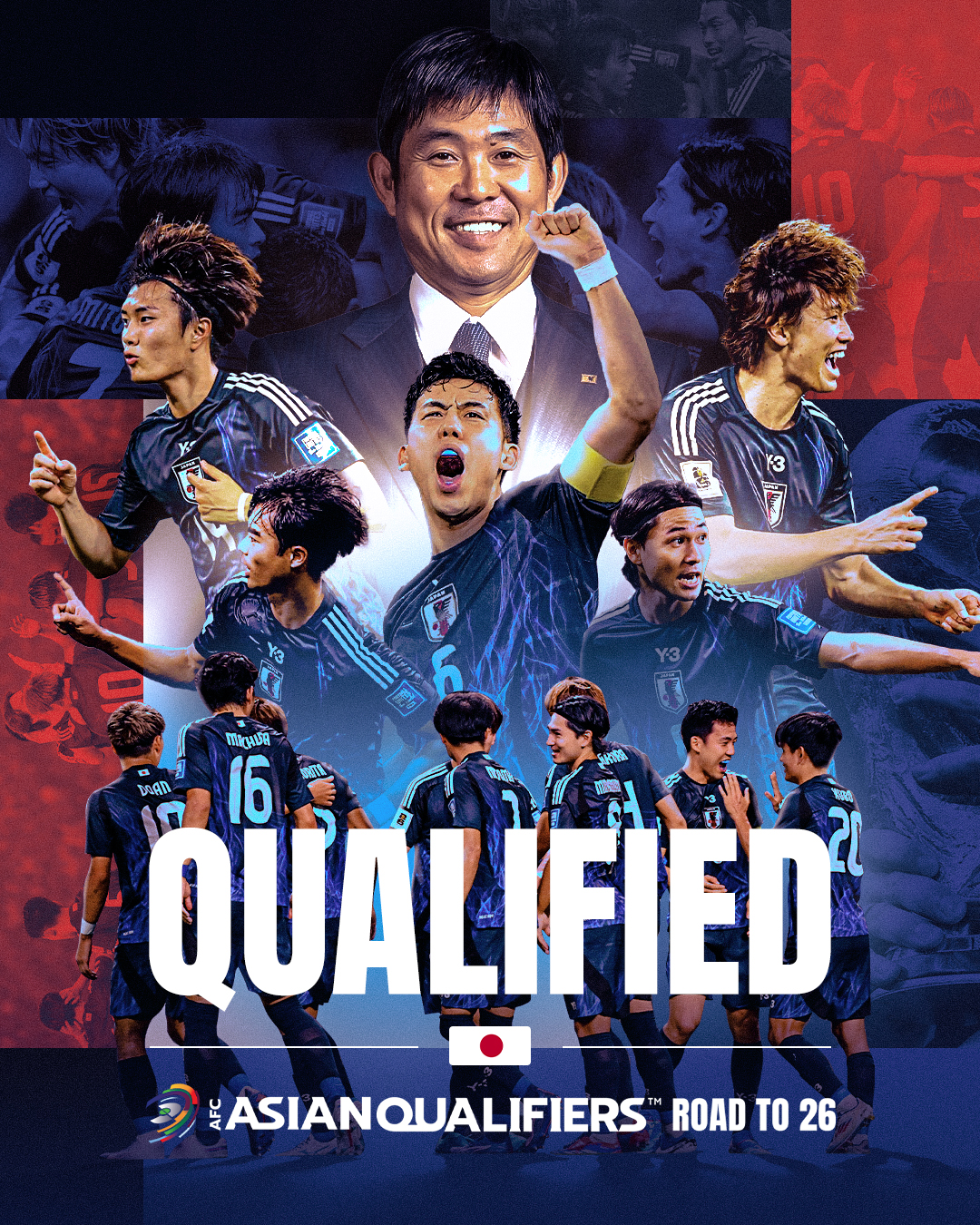Japan made history by becoming the first Asian nation to secure a spot in the 2026 FIFA World Cup. This achievement not only represents a milestone for Japan’s national football team but also has significant implications for the evolution of Asian football as a whole.
As the 2026 World Cup approaches, this historic qualification is a testament to Japan’s continuous growth in the sport, its commitment to excellence, and its determination to compete on the world stage.
The Road to 2026: Japan’s Journey in World Cup Qualifying
Japan’s road to qualification for the 2026 World Cup was neither easy nor without challenges. For the first time in history, the 2026 World Cup will feature 48 teams, an expansion from the previous 32-team format.
This change significantly altered the dynamics of qualifying, providing more opportunities for teams from different regions to secure their place in the tournament. For Japan, securing a spot in this expanded competition was both an opportunity and a challenge that they would need to embrace.
The Shift in World Cup Qualifying Format
The change in the World Cup qualifying format came as part of FIFA’s broader efforts to globalize the game and provide more nations with a chance to participate in football’s most prestigious tournament.
The 2026 World Cup, jointly hosted by the United States, Canada, and Mexico, marks the first time the tournament will be played with 48 teams. For the Asian Football Confederation (AFC), this meant that the qualification process would be more competitive than ever before, with more teams in Asia vying for a limited number of spots.
While the exact number of World Cup slots allocated to the AFC had yet to be fully determined at the time of writing, it was clear that Japan would need to remain at the top of their game to ensure their qualification. Japan’s national team, known as the Samurai Blue, has consistently been one of the strongest teams in Asia, but the competition from other regional powers such as Iran, South Korea, and Australia was fierce.
The Qualifying Campaign: Strategy, Leadership, and Teamwork
Japan’s qualification journey began with the Asian qualifiers, a complex multi-stage process that started years before the final ticket to the 2026 World Cup was secured. The Samurai Blue faced a series of tough opponents, each match testing their resolve, tactical acumen, and adaptability.
Under the guidance of head coach Hajime Moriyasu, Japan adopted a playing style that combined discipline, technical precision, and a strong team ethic. Moriyasu, who took over the national team in 2018, had worked to instill a tactical approach that prioritized ball possession and quick transitions. The emphasis on a cohesive team structure rather than individual brilliance was key to Japan’s success in the qualifiers.
Throughout the campaign, Japan’s defensive solidity stood out, with players like Maya Yoshida, Takumi Minamino, and captain Eiji Kawashima playing pivotal roles in ensuring Japan remained a tough side to break down. Moreover, Japan’s attacking options were varied and dangerous, with players such as Kyogo Furuhashi and Takefusa Kubo showcasing their skill and creativity in the final third. The team’s depth and versatility were on full display, as different players stepped up to make crucial contributions throughout the qualifiers.
The Significance of Japan’s Qualification
For Japan, this qualification is monumental. While Japan has appeared in every World Cup since their debut in 1998, this marks a new phase in their footballing history. By becoming the first Asian nation to qualify for the 2026 World Cup, Japan has demonstrated its leadership in the region and its ongoing commitment to football excellence. The Samurai Blue’s achievement is not only a source of national pride but also a symbol of progress for Asian football as a whole.
The qualification also comes at a time when Japanese football has been experiencing significant development, both in terms of the domestic league (J1 League) and the international presence of its players. In recent years, Japan has produced some of the best footballing talent in Asia, with many of its top players plying their trade in Europe’s top leagues. The steady growth of the domestic league, which has seen increasing investment and development, also contributes to Japan’s continued success on the international stage.
The Impact on Asian Football
Japan’s qualification for the 2026 World Cup is not just an achievement for the nation; it also has far-reaching implications for the broader Asian football community. The success of Japan, as the first Asian nation to secure a place in the tournament, serves as a catalyst for the further growth and development of football across the continent.
Raising the Profile of Asian Football
Japan’s qualification enhances the visibility of Asian football on the global stage. As one of Asia’s most successful footballing nations, Japan’s continued presence in the World Cup inspires hope and ambition for other nations in the region. Countries like Iran, South Korea, and Australia, who have also consistently qualified for World Cups, now face the challenge of keeping pace with Japan, whose footballing standards continue to rise.
The success of Japan’s football system and its national team can also provide a valuable blueprint for other Asian nations. Japan has invested heavily in youth development, coaching, and infrastructure, creating an ecosystem that supports the growth of football talent at every level. As a result, many countries in Asia are looking to Japan as a model for improving their own football programs. With the growth of the sport in Asia, the region is poised to become an even more influential force in the global football landscape.
Increased Competitive Balance in the AFC
Japan’s qualification highlights the increasing competitiveness within the AFC. While Japan has traditionally been one of the top teams in Asia, the gap between the region’s top footballing nations has narrowed in recent years. Countries like Iran, South Korea, Saudi Arabia, and Australia have all made strides in improving their football infrastructure, and this has resulted in tighter competition for World Cup spots.
This heightened competition not only raises the standards of football in Asia but also forces nations to rethink their approach to the sport. The growing investment in football development, coaching education, and youth training is likely to benefit the entire region in the long term. As more Asian teams qualify for the World Cup and challenge for honors on the global stage, the continent will continue to carve out a larger presence in the sport.
Promoting Football Culture and Unity Across Asia
Japan’s qualification also provides an opportunity to foster unity and collaboration among Asian nations. As the first Asian team to secure their spot in 2026, Japan can lead efforts to create stronger footballing ties within the region. Through organizing friendly matches, joint training camps, and collaborative development programs, Japan has the potential to help nurture the next generation of football stars in Asia.
Additionally, Japan’s success story can serve as a beacon of hope for nations with less established footballing traditions. Teams such as Thailand, Vietnam, and Iraq have shown promise in recent years, and Japan’s example can inspire them to invest more in the sport and believe in their potential to succeed on the international stage. With Japan leading the way, the future of football in Asia looks brighter than ever.
Looking Ahead: Japan’s Aspirations for 2026
With their qualification secured, Japan now turns its attention to the 2026 World Cup. While the team’s focus remains on preparing to compete against the best teams in the world, Japan has big ambitions for the tournament. The Samurai Blue will be aiming not only to advance beyond the group stage but to challenge for a place in the knockout rounds. With a squad filled with talented players plying their trade in Europe’s top leagues, Japan is poised to make an impact in 2026.
For Japan’s head coach, Hajime Moriyasu, the 2026 World Cup represents the culmination of years of hard work and preparation. Moriyasu, who has earned praise for his tactical acumen and leadership, will look to fine-tune his team’s strategy ahead of the tournament. As Japan has always prided itself on its discipline, hard work, and team unity, the Samurai Blue will bring a well-organized and competitive side to the World Cup, ready to face any challenge.
Japan’s youthful and talented roster, with emerging stars like Takefusa Kubo and Kyogo Furuhashi, will undoubtedly be one of the team’s key assets. However, the veterans, including players like Maya Yoshida and Eiji Kawashima, will be critical in providing leadership and experience during the pressure-filled moments of the World Cup.
Japan’s qualification for the 2026 FIFA World Cup is a significant achievement for the nation and a landmark moment for Asian football. As the first Asian team to secure their spot in the tournament, Japan has once again proven its dominance in the region and underscored the strides the country has made in developing a world-class footballing culture. With their eyes set on the 2026 World Cup, Japan’s national team aims to not only make their mark on the tournament but also to continue inspiring future generations of footballers across Asia.
This qualification is a powerful reminder that football is a global sport that transcends borders and unites people through their love for the game. As Japan continues its footballing journey, the entire continent of Asia can take pride in its achievements and look forward to even greater success in the future.
Image Courtesy: afcasiancup/X

